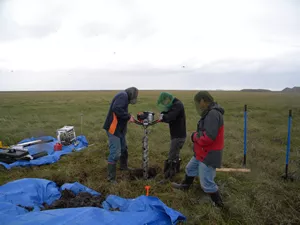This is a press release from the National Snow and Ice Data Center (NSIDC), which is part of the Cooperative Institute for Research in Environmental Sciences at the University of Colorado at Boulder.
One- to two-thirds of Earth's permafrost will disappear by 2200, unleashing vast quantities of carbon into the atmosphere, says a study by researchers at the Cooperative Institute for Research in Environmental Sciences (CIRES) National Snow and Ice Data Center (NSIDC).
"The amount of carbon released is equivalent to half the amount of carbon that has been released into the atmosphere since the dawn of the industrial age," said NSIDC scientist Kevin Schaefer. "That is a lot of carbon."
The carbon from permanently frozen ground—known as permafrost—will make its impact, not only on the climate, but also on international strategies to reduce climate change Schaefer said. "If we want to hit a target carbon concentration, then we have to reduce fossil fuel emissions that much lower than previously calculated to account for this additional carbon from the permafrost," Schaefer said. "Otherwise we will end up with a warmer Earth than we want."
The carbon comes from plant material frozen in soil during the ice age of the Pleistocene: the icy soil trapped and preserved the biomass for thousands of years. Schaefer equates the mechanism to storing broccoli in the home freezer: "As long as it stays frozen, it stays stable for many years," he said. "But you take it out of the freezer and it will thaw out and decay."
Now, permafrost is thawing in a warming climate and—just like the broccoli—the biomass will thaw and decay, releasing carbon into the atmosphere like any other decomposing plant material, Schaefer said. To predict how much carbon will enter the atmosphere and when, Schaefer and coauthors modeled the thaw and decay of organic matter currently frozen in permafrost under potential future warming conditions as predicted by the Intergovernmental Panel on Climate Change.
They found that between 29 and 59 percent of the permafrost will disappear by 2200. That permafrost took tens of thousands of years to form, but will melt in less than 200, Schaefer said.
The scientists used a model to predict how much carbon the thawing will release. They estimate an extra 190 plus or minus 64 gigatons of carbon will enter the atmosphere by 2200—about one-fifth the total amount of carbon currently in the atmosphere today. Carbon emissions from thawing permafrost will require greater reductions in fossil fuel emissions, to limit the atmospheric carbon dioxide to some maximum value associated with a target climate, Schaefer said. "It means the problem is getting more and more difficult all the time," he said. "It is hard enough to reduce the emissions in any case, but now we saying that we have to reduce it even more."
The study is published online in February 16 in Tellus. Coauthors on the study include CIRES Fellow and senior research scientist Tingjun Zhang from NSIDC, Lori Bruhwiler of the National Oceanic and Atmospheric Administration (NOAA), and Andrew Barrett from NSIDC. Funding from the project came from the National Aeronautics and Space Administration, NOAA and the National Science Foundation.
Contacts
Kevin Schaefer, CIRES/NSIDC, +1 303.492.8869, Kevin.Schaefer@nsidc.org
NSIDC Communication, +1 303.492.1497, press@nsidc.org
More information
The article is available online at http://onlinelibrary.wiley.com/doi/10.1111/j.1600-0889.2011.00527.x/full
For more information about carbon and frozen ground, see the NSIDC All About Frozen Ground Web site.
